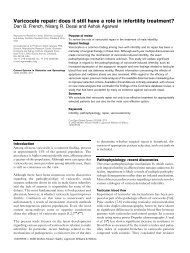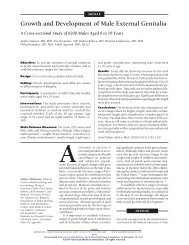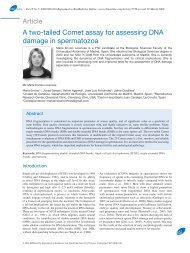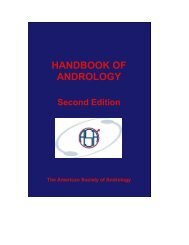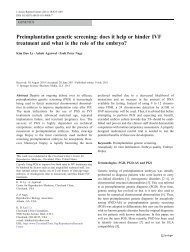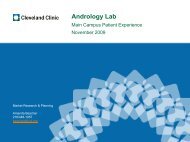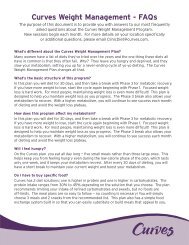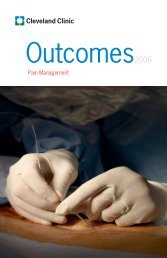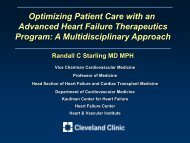clevelandclinicmagazine - Best Hospitals, US News best hospitals
clevelandclinicmagazine - Best Hospitals, US News best hospitals
clevelandclinicmagazine - Best Hospitals, US News best hospitals
- No tags were found...
You also want an ePaper? Increase the reach of your titles
YUMPU automatically turns print PDFs into web optimized ePapers that Google loves.
The lack of gravity leaches away strength and muscle tone,while radiation from solar winds, flares and galactic cosmicrays increases the possibility of cancer.Risks aside, humans have longdreamed of getting off the “rock” andexploring the worlds around the Earth- not to mention traveling throughoutthe rest of the Milky Way. As the spacerace of the 1960s propelled us forwardto the current day space shuttleprogram and the International SpaceStation, scientists and researchershave attacked the problems that arepart and parcel of living and workingin space. Building and testing solutionson the ground and in orbit, theywork toward our most ambitious goalyet: the odyssey to Mars.At The Cleveland Clinic, the newlycreated Center for Space Medicine islending the National Aeronautics andSpace Administration (NASA) a handin solving some of the many medicalproblems experienced by humans duringlong-term space flight. Headed byPeter Cavanagh, Ph.D., D.Sc., Chairmanof the Cleveland Clinic’s Departmentof Biomedical Engineering; andJames Thomas, M.D., Section Head ofCardiovascular Imaging, the center isworking closely with engineers and scientistsat NASA Glenn Research Centerin Cleveland.“NASA brings the rich heritage of ourunderstanding of microgravity [zerogravity] to this collaboration. Workingwith the Clinic allows us access to alarge, expert staff of biomedical researchersand clinicians,” says MarshaNall, Bioscience and Engineering Pro-gram Manager for NASA Glenn. “It’s awonderful opportunity for NASA. TheCenter for Space Medicine provides uswith a direct link to the premier researchat The Cleveland Clinic as weidentify biomedical issues that mustbe resolved in support of NASA’s ‘Visionfor Exploration’ plan, which wasoutlined by President Bush last year.”The biomedical issues involvedin long-term space flight presentmajor challenges.“Two show-stoppers for interplanetaryflight are radiation and bone loss,”says Dr. Cavanagh. “Until those twoproblems are solved, there is very littlehope we can really spend long periodsof time in space.”Radiation exposure becomes a criticalconcern for travel outside of lowEarth orbit. Intense solar flares releasevery-high-energy particles that can beas hazardous to human health as thelow-energy radiation from nuclearblasts. The Van Allen radiation belt, abroad band of magnetism that surroundsthe Earth and deflects particles,protects the planet from the harmfuleffects of solar flare radiation.“Once you travel outside the belt,you’re subject to very-high-energyparticles from the Sun and deep cosmicspaces, and these particles causedamage to the body,” says Dr. Cavanagh.“They literally destroy cells andmake a tunnel through the brain,leaving a track behind them.” Thesehigh-energy particles pass throughhuman tissue with ease, causingdamage to DNA and greatly increasingcancer risk.When they pass through the visualcortex of the brain, the perception isone of bright flashes of light. Dr. Cavanaghsays these particles are probablythe cause of the bright flashes theApollo astronauts commented on whenthey were on the moon.To protect current and future spacetravelers, two very different approachesto the radiation issue are being studied.One team at the Clinic is workingon a way to shield, screen and deflectthe particles in the same way the VanAllen belt does. This method requireshigh field magnets that have not yetbeen flown in space. When used aboardthe spacecraft, these magnets wouldprovide a safe haven for astronautswhere at least a portion of the vehiclewould be sheltered from radiation.Another team is working on interventionat the cellular level to protectsensitive tissues from radiation. SaysAndrei Gudkov, Ph.D., Chairman ofMolecular Genetics, “Specifically,we’re developing drugs that repressthe natural mechanism in each cellthat normally triggers cell death.We’ve already identified several compoundsthat, acting through thismechanism, are effective ‘radioprotectants,’allowing the cells, and ourmodels, to survive otherwise lethaldoses of radiation.”On May 19th, 2005, NASA’s Mars Exploration Rover Spirit captured this view as the sun sank below the rim of Gusev crater on Mars.www.clevelandclinic.org 23



